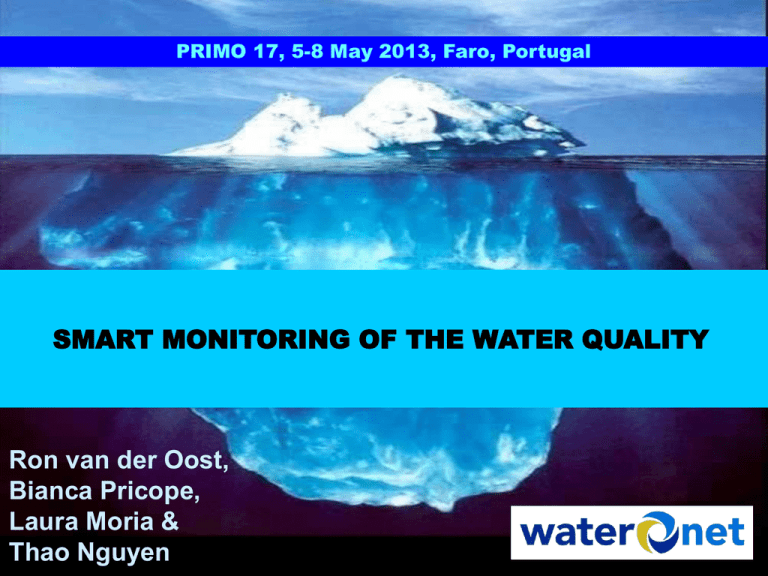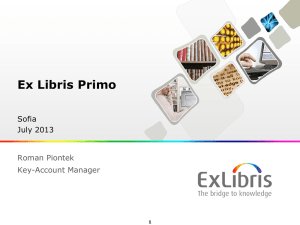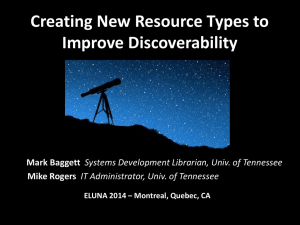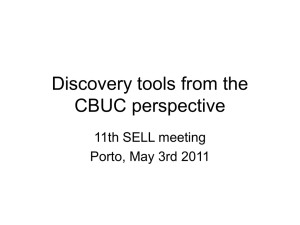smart monitoring - Waternet Innovatie
advertisement

PRIMO 17, 5-8 May 2013, Faro, Portugal SMART MONITORING OF THE WATER QUALITY Ron van der Oost, Bianca Pricope, Laura Moria & Thao Nguyen Research & Engineering Waternet Surface and ground water Atmosphere Waste water Drinking water PRIMO 17 2 Outline • Smart monitoring of the water quality • Bioassays & passive sampling • Discussion & conclusions PRIMO 17 3 WFD monitoring guidelines Chemical status: 33+ priority pollutants Ecological status: 5 groups populations Measures to improve the water quality have to be taken if monitoring indicates no good chemical or ecological status! PRIMO 17 4 Monitoring substances or effects? • Substances: – selected priority pollutants (e.g. 33 for EU WFD) • Effects: – General toxicity: effects of total mixture of pollutants – Specific toxicity: effects of substances with a similar mechanism of toxic action; high sensitivity! – Unknown cause of effect (TIE/EDA needed) More reliable risk assessment by use of toxic screening prior to relevant chemical analyses PRIMO 17 5 Smart monitoring project Alternatives for WFD monitoring: • Integrated monitoring (chemistry, biology & toxicology) • Time-integrated monitoring (passive sampling) • Toxic in vitro screening to identify risks and ‘hot spots’ • Risk analysis of most relevante micropollutants (TIE, EDA) • Application of innovative techniques (‘omics’) Goal: more information on water quality for less €$! PRIMO 17 6 Alternatives for WFD monitoring Non-chemical stress factors Integrative monitoring Guidelines Chemical status: priority pollutants Relationships: link? bioassays (EDA) PRIMO 17 Ecological status: populations 7 (Passive) sampling metals & organics Smart monitoring: environment Toxicity traffic light! yes Above threshold? Routine chemistry HIGH RISK no Hazard assessment: Above threshold? Cheap & simple assays General toxicity yes POTENTIAL RISK Risk assessment: Advanced chemistry TIE, EDA, ADME no Specific toxicity yes Above threshold? no LOW RISK Simple tool for regulators & policy makers Smart monitoring: version 1.0 Routine chemistry General toxicity Specific & reactive toxicity Metals, PAHs, PCBs (OCPs) Microtox, Algae, Daphnids (Anti-)estrogens, (Anti-)androgens, dioxin-like, mutagenic PAH, antibiotics, genotoxicity (P53 and P21) Outline • Monitoring of micropollutants in the water cycle • Bioassays & passive sampling • Design of a ‘smart monitoring’ strategy PRIMO 17 10 Passive sampling: time integration Grabsamples Passive sampling • Grabsamples are ‘snapshots’ • PS is better for trends & time weighed average • Lower sampling frequencies needed with PS 18/8 2011 PRIMO 17 11 Bioaccumulation vs. passive sampling PAH bioaccumulation vs. Passive sampling 7.0 PAH [µg/g dw] 6.0 5.0 4.0 3.0 2.0 1.0 0.0 VS6 VS5 VS4 VS3 VS2 VS1 site 1993, mussels 2010, PS calculations PRIMO 17 12 Daphnids: acute toxicity 3 • Acute toxicity in nonpolar PS extracts 2.5 TU 2 Daphniatox 1.5 1 0.5 0 P-B P-A1 P-A2 P-A3 P-K1 P-K2 P-K3 P-K4 SR-B SR-K1 SR-K2 SR-K3 SR-K4 Locaties PRIMO 17 13 RIKILT WATER-SCAN: antibiotics effect A. Antibiotica activiteit POCIS N 1.6 2010 2011 1.4 1.2 µg AEQ P 1.8 Tetracycline 1.0 Quinolonen 0.8 Macroliden/β-lactam Sulphonamides 0.6 Aminoglycosiden 0.4 0.2 0.0 BS AS1 AS2 AS3 AS1 AS2 AS3 locaties • Different types of antibiotics activity in polar wwtp extracts PRIMO 17 14 Reporter gene assays: Anti AR-CALUX anti-AR CALUX POCIS & SR 40000 Flu-eq [ng/ml extract] 35000 30000 25000 20000 15000 10000 5000 0 POCIS A1 A2 A3 K1 K2 K3 K4 LOD SR B A1 A2 A3 K1 K2 K3 K4 B Sites • Strong anti-androgenic activity in both polar and non-polar PS extracts PRIMO 17 15 Outline • Monitoring of micropollutants in the water cycle • Bioassays & passive sampling • Design of a ‘smart monitoring’ strategy PRIMO 17 16 Vision on future monitoring • Chemical analyses will always be needed, but they are most useful if you know what you are looking for… • For an overall risk assessment the use of chemical analyses alone is insufficient, but a combination of chemical and toxicological monitoring is necessary, and may be less expensive! • Comparable strategies for all water cycle compartments PRIMO 17 17 Cost reductions on monitoring Passive samplers Water Chemical analyses In vitro Bioassays (+AM) populations A. Lower sampling frequency whem timeintegrated sampling is used; alternative for biota analyses B. Only advanced chemical analyses after responses in tox-screening C. Bioassay screening and innovative DNA testing to reduce costs for ecological testing PRIMO 17 18 Cost reductions on monitoring • WFD chemical monitoring – 12x grabsamples (each month) – Chemical analyses of 33 priority pollutants – Costs around €40,000 • Smart monitoring, version 1 – – – – – 4x passive sampling (each season) Chemical analyses of metals/PAH/PCB/OCP Toxicological analyses with 3 general & 9 specific bioassays Costs around €10,000 Additional analyses only at sites with potential risk! PRIMO 17 19 Uncertainties? • Bioassays – No (sensitive) response to all pollutants Uncertainties of combination? • Passive sampling – Not all compounds accumulate in samplers • Grab sampling – Snapshot; no information on bioavailability • Chemical analyses of priority pollutants – No information on 99,000 other chemicals in water cycle… PRIMO 17 20 What do we need…? • • • • • • • Additional research on integrative monitoring (many projects) Further calibration of (polar) passive sampling (NIOZ, Deltares) Design of more ‘simple’ bioassays for effect measurement (BDS) Design of trigger values for classification of effects (DEMEAU) Design of trigger values for bioassay-PS combinations (SM) Design of less expensive EDA/TIE (HT-EDA, EDA Emerge) Develop simple tools for regulators/policy-makers (SM) Paradigm shift: substances PRIMO 17 risks! 21 Thanks! Research & Innovation Steering Group PRIMO 17 22






